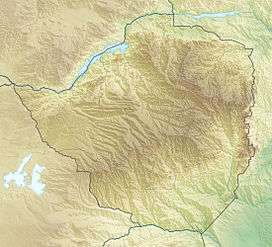Hwange Thermal Power Station
| Hwange Thermal Power Station | |
|---|---|
 Location of Hwange Thermal Power Station within Zimbabwe | |
| Country | Zimbabwe |
| Location | Hwange |
| Coordinates | 18°23′0.155″S 26°28′12.03″E / 18.38337639°S 26.4700083°ECoordinates: 18°23′0.155″S 26°28′12.03″E / 18.38337639°S 26.4700083°E |
| Status | Operational |
| Construction began | 1973 |
| Commission date | 1987 |
| Operator(s) | ZESA |
| Thermal power station | |
| Primary fuel | Bituminous coal |
| Power generation | |
| Units operational |
4 x 120 MW 2 x 220 MW |
| Make and model |
ICAL Babcock Power MAN Alstom Ansaldo Energia |
| Nameplate capacity | 920 MW |
The Hwange Thermal Power Station is the biggest power plant in Zimbabwe with an installed capacity of 920 MW. It is owned and driven by the national electricity company ZESA Holdings (Pvt) LTD.
It was built in two stages and consists of 4 units of 120 MW each and 2 units of 220 MW each. Engineering Consultants, Merz & McLellan, were employed for the design and supervision of the construction of the power station. Construction of Stage 1 commenced in 1973, but was suspended in 1975 due to economic sanctions imposed on Rhodesia. Stage 1's units were commissioned from 1983 to 1986 with Stage 2's units following in 1986/87.[1]
A reliable source of water lies further north, in the Zambezi River. From there, through a 44 kilometre long pipeline, water for the Boilers and Cooling Towers is drawn by both high and low lift pumps to a storage reservoir located adjacent to the station and conveyed by gravity to the station. About 107,000 cubic meters of raw water can be provided per day; while the demineralisation plant has a capacity of 5,420 cubic metres per day.
A 3.5 kilometre conveyor belt brings about 1,750 tonnes of coal per hour from the nearby Wankie colliery open cast mine, and 250,000 tonnes of coal are stockpiled on site. Coal reserves estimated to support 1,200 MW for an estimated 30 years are concealed beneath the vast expanse of the coal mine.
Technical problems due to neglect of maintenance, part replacement and upgrading make the plant prone to frequent production stops. In 2009, Namibia's NamPower made agreements to help ZESA to revive the plant’s capacity in exchange for power deliveries.[2] The extensive problems are however continuing and have even led the government to considering a full close-down of the plant.[3]
In December 2015 China agreed to provide a $1.2 billion loan to add 600 MW of generating capacity to the Hwange station.[4]
References
- ↑ "Power Stations - Zimbabwe Power Company : Hwange Power Station.". Archived from the original on October 29, 2012. Retrieved 2013-01-26.
- ↑ "Engineering News online: Botswana, Namibia to ramp up Zim power generation". Retrieved 2010-03-21.
- ↑ "Reuters: Zimbabwe mulls decommissioning Hwange power plant". 2010-03-03. Retrieved 2010-03-21.
- ↑ Zimbabwe: China promises $1.2bn loan for Hwange thermal power plant upgrade
External links
- IndustCards - Coal-Fired Power Plants in Africa, retrieved 2010-03-22